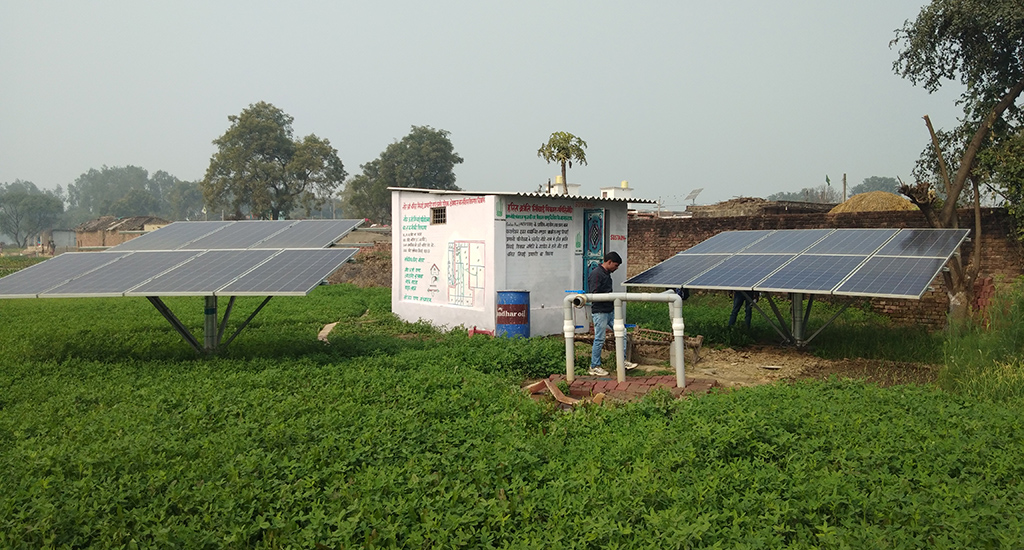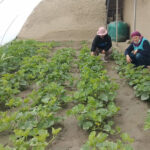Farmers in India currently depend heavily on grid-connected electricity and diesel pumps for crop irrigation. Expensive diesel engines increase farm input costs and contribute to carbon emissions. It was no different for farmers in the Bahraich district of Uttar Pradesh.
Agriculture is the mainstay of Bahraich district. The average landholding size is low. Some farmers practice rain-fed agriculture, depending only on rainwater for irrigating their crops. Many small and marginal farmers rent diesel pumps which are highly polluting. This also results in high cost of irrigation.

To reduce the cost of irrigation, Aga Khan Foundation is implementing the Unnat Kheti programme through community-owned solar-based irrigation systems.
How does a community-owned irrigation system work?
A committee called Sinchai Vikas Samiti is formed in the village. It is basically a user group for a solar irrigation system and is made up of 15-20 farmers.
Each committee has a president, secretary, treasurer and a pump operator, besides a bank account. The committee forms rules and norms for water user fee and manages the day-to-day functioning of the system.
The process of installing a community-owned solar-powered irrigation system begins with identification of clusters and measurement of catchment area and formation of Sinchai Vikas Samitis. This is followed by mapping the command area of each irrigation system and deciding on the layout for the buried pipeline.
Trenching for pipeline, bore well and pump house construction work is then done by the user group through community contribution.
Usage norms include distribution of water as per a member’s needs, collection of irrigation fee by the operator and depositing the collected amount in the committee’s bank account.

Transparency is maintained by installing water meters to avoid disputes. There is flexibility in payment – that is a farmer member can delay payments if short of money. In case of consistent non-payment the farmer does not get water till the previous irrigation fee is paid.
Benefits of community-based solar-powered irrigation systems
Community-owned solar irrigation systems are environment friendly and affordable. As they are a dependable source ensuring access to irrigation, farmers can grow high-value crops throughout the year.
Solar-powered irrigation systems are less labour intensive and reduce water percolation loss due to buried pipelines. While this lowers the cost of irrigation, it translates as increased income.
They are also eco-friendly as there is no carbon dioxide emission. Approximately 400 diesel pumps have been uninstalled in the project catchment area.

Though maintaining equity, uniformity and transparency in the user groups is a challenge at times, the Sinchai Vikas Samiti promotes active participation of the farmers, ensuring long-term sustainability of the system. The committee ensures a mutual responsibility for a common objective. Economic contribution and self-management instills a sense of ownership, self-respect and self-reliance amongst member farmers.
Impact of the solar-powered irrigation systems
In the Chittaura and Risia administrative blocks of Bahraich district, 50 solar irrigation systems with flow meters have been installed across 30 villages. These cover 900 acres of farmland and benefits 1,000 farmers.
The program has led to increased income and prosperity amongst the farmers of Bahraich.
Water usage is as per crop needs. Farmers pay user fee as per the water meter reading. User fee is Rs 1.5 per unit (1,000 cft water), much lower than the cost of irrigation using diesel pumps.
Diesel pumps cost Rs 300-400 bigha per irrigation. So in a year’s crop season, every farmer’s irrigation expenditure was Rs 5,000-8,000. After the community-based solar-powered irrigation systems were installed, the farmers’ annual irrigation expenditure is Rs 800-1,000.
Crops are also irrigated on time, which has increased the yield. As of today Rs 25,000 to Rs 40,000 is deposited in each solar irrigation committee’s account.
In all the solar irrigated areas, farmers can cultivate crops in all the three seasons (rabi, kharif and zaid) because of the availability of water.

Farmers in this area have started cultivating chilli, okra, brinjal, bitter gourd, bananas, radish, spinach, cauliflower and mint, in addition to the traditionally grown wheat, paddy and maize.
Financially also farmers are benefitting from reduced costs through the low irrigation charges and reduced labour requirements.
The lead image shows a community-owned solar pump that is providing farmers with a low-cost, eco-friendly system of irrigation (Photo by Tavish Malik)
Tavish Malik works as the Project Coordinator at Aga Khan Foundation (India) and executes various development projects in Rajasthan.








